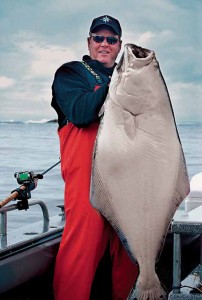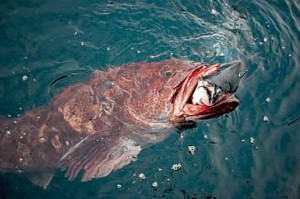Ahhhhhh, April, we made it. Springtime, with summer on the horizon and winter in the rear view mirror. Yes!
As I have written in the space more than once, my fishing calendar is, for the most part, a 12 -month gig. If you like the Pacific Northwest saltwater scene as much as I doxiao cheng, there is so much to do and for an aging cat like me, I never, ever get tired or bored of boating and fishing. It is my occupation and my recreation. That’s the payoff for being Mother Theresa in another life. Really?

Doug Tallman, Olympia, redefines the definition of a good day after boating this 84 – pound halibut. The Washington halibut season is just around the corner and Admiral Fish suggests it’s not too early to get
your halibut fishing gear ready to go.
For most marine areas in the Strait of Juan de Fuca, the Islands and north Puget Sound, April represents the last act before these areas close down to salmon fishing in May and June, as they do every year. Don’t even think about heading for the hammock because here comes the lingcod, halibut and shrimp seasons, conveniently when salmon fishing is buttoned up.
I do most of my lingcod and halibut harvesting in southeast Alaska or off the west coast of Vancouver Island, due to a greater abundance and more liberal regulations and these fish are about as plentiful as fleas on a junk yard dog’s back. Got a visual?
But hey, lingcod fishing can be decent off the south end of Whidbey, artificial reefs from Olympia to Camano Island, the north end of Admiralty Inlet near Keystone, some of the banks in the Strait or out at Neah Bay, particularly off WaddahIsland. In most cases, the rockier the habitat, the greater the abundance. It’s been my experience that lingcod are particularly aggressive when the season first opens as both the male and female lings are coming off the late winter spawn. Big female lings (most lings over 20 pounds are females) lay their egg mass in a very rocky habitat. Immediately, the male lings move onto the nest and protect the eggs from predators.economical inflatable water park with wave slide
If there are no attempted raids on the nest, he loses significant weight over the 40 or so day incubation period. If any marine fish, or other bottom dweller such as an octopus moves in on the egg mass, Mr. Lingcod does his munchy crunchy and down the hatch. Reminds me of a few of my fishing buddies around the dinner table.
Halibut spawn in the dead of winter, typically in deep water in the Strait or ocean, before migrating onto many of the banks in the eastern Strait of Juan de Fuca for their spring and summer foraging program. Middle, Hein and Eastern Banks have been particularly consistent the last few years and salmon anglers have hooked and released respectable numbers of halibut during the last month and a half. Connect the dots, dude, the fish are there. Check the WDFW website for specific seasonal information as it changes from year to year, based on estimated abundance predictions.
And if fishing for halibut or lings does not float your boat, next month is also time to fish for spot shrimp. While Hood Canal gets a lot of shrimpers attention for their extremely restrictive sport season, never overlook the southern San Juans, especially the southwest corner of Lopez Island, near Iceberg Point in around 190 feet of water. Money!

The Puget Sound lingcod season opens in the middle of April, for a six week limit. Lings are known for eating anything that moves, including this small salmon, having a bad day. Photo by Ryan Dicks.
I’ve been using the McKay shrimp pots during the last few years. You’ll find them at Outdoor Emporium in Seattle and John’s Sporting Goods in Everett. They clearly fish better than historical, traditional pots I have used. Some say, due to the octagon design of the pots, it’s easier for the shrimp, moving around the pot, to find the doors, versus the square or rectangular pots. Maybe. I can tell you this . . . they work!
Salmon Seasons Announced Soon
By the end of the first week of April, the Washington Department of Fish and Wildlife will announce the full sport salmon season package, effective through March 31st, 2015. I am also assuming, you have read or heard the news about the record king salmon run forecasted for the Columbia River. If you would have told me the forecast is calling for 1.6 million kings, two months ago, I would recommend a trip to Shick Shadle Hospital. How can this be, 1.6 million king salmon? As one colleague biologist suggested to me, “Buddy, we are gonna need more water!” Mercy! Throw in another 1.2 million coho. Dude! It is gonna be the show of all time. I’ve rented a house for a week, got my moorage reservation, now, come to papa.
One of the phenomenas I have witnessed during big salmon runs, is the curve on the graph begins earlier, and ends later. Therefore, from Neah Bay in early-mid July, followed by La Push, Westport and Ilwaco, a tsunami of king salmon is headed our way. Incoming! I can’t wait.
Giddy-up and get your summer fishing plans in place, while you’re soaking your worm in the water for lingcod, halibut and shrimp this spring. It will likely be a stampede for the fishing grounds, and, with any luck, that’s me riding at the front of the herd. Hi-Ho Silver, awayyyyy! See you on the water.